|
|
|
Tatar Calligraphy (66-70)
И.М.Покровский һәм Н.Ф.Катанов тупланмалары
66
Карәнҗә догасы. Шамаилнең үзәгендә хиҗринең 25 нче елында Госман хәлифә (раг) үтерелгән вакытта язган аять: «Фәсәякфикәһүм Аллаһ вә һүә самигыл-галим». Ике ягында “Лә хәүлә вә лә куатә иллә билләһил-галиел-газыйм”нең фазыйләтләре. Шамаилнең кырыйларында Карәнҗә догасы.
Молитва Каранджа. В центре шамаиля написан аят из Корана, во время переписывания которого бы убит халиф Госман (р.а.г.) в 25 году хиджры - «И сделает достаточным тебе их Аллах. Он Слышащий и Знающий». По краю всего шамаиля приведена молитва Каранжа, сверху написаны ценности «Ля хауля ва ля куата илля билляхиль галиел газим». Литография Казанского университета.
Prayer of Karandj. In the center of shamail there ayat is written according to it caliph Usman (rasul Allahu ganhu) was killed in 25 year hidzhri: “Allah will make it sufficient to you. He is who hears and knows”. On the edge of all shamail the prayer of Karandzh is given and also values of “La haula va la kuata illa billahil alil gazim” are given - “there is no force and power except for Supreme Majestic Allah Subhana va Tagala”. Lithography of Kazan University.
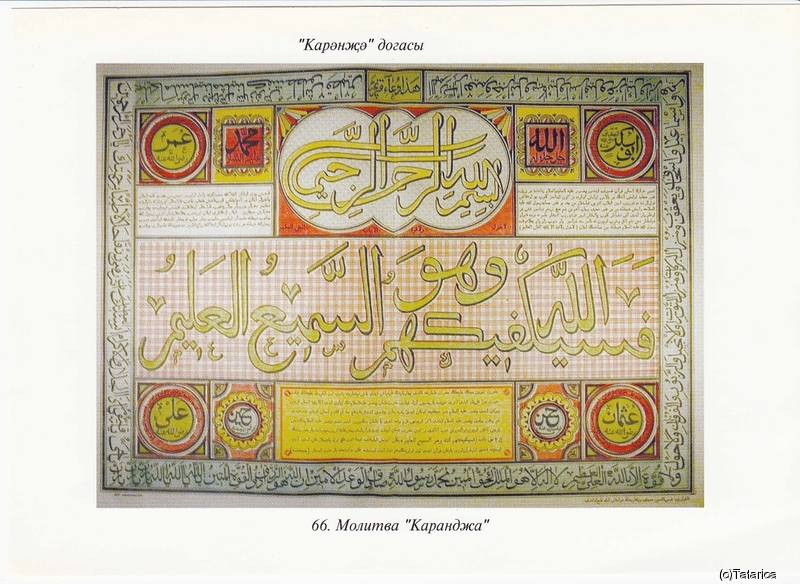
67
Суфый халәте. Аллаһы Тәгаләгә гашыйк булшан бәндәнең күз яшеннән дәрья хасил булу мисалы.
Озеро слез. Озеро, образованное лт влюбленного в Аллаха Субхана ва Тагаля.
Lake of tears. Lake is formed from tears of Sufi's love with Allah Subhana va Tagalya.
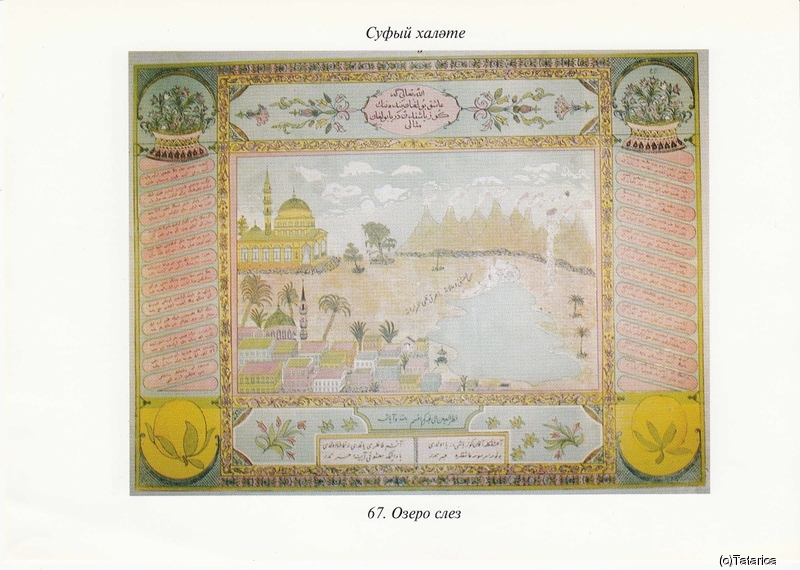
68
Мәкаль. Тиген килгән тәңкәдән тир чыгарган тиен яхшы. Тырышкан табар, ташка кадак кагар.
Пословица. Копейка, добытая потом дороже, чем рубль, найденный без труда. Кто ищет, тот найдет, в камень гвоздь вобьет. Ручная работа. 30Е годы ХХ века.
Proverb. Penny extracted, then more expensive, than ruble found without effort. Who searches for that, will find, a nail in a stone will hammer. Hand work. 30th of XX century. 44x66.
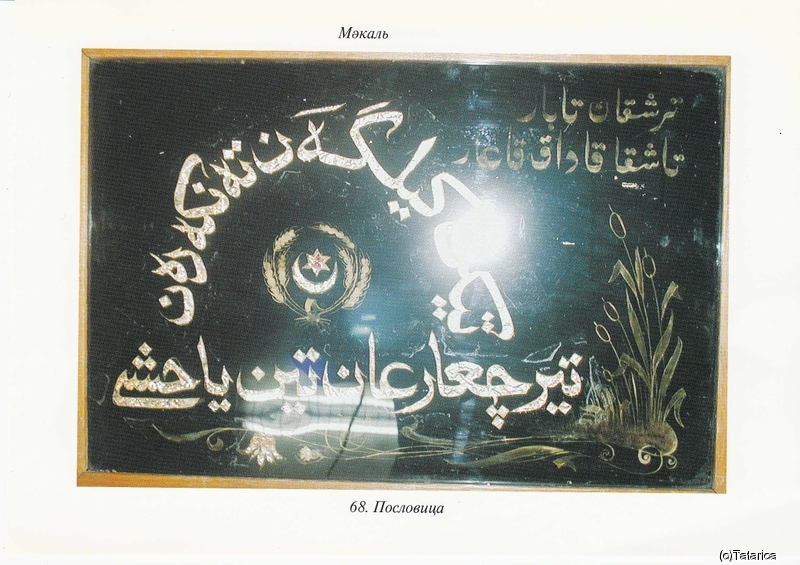
69
Аятелкөрси. Шамаилдә Аллары Тәгаләгә иң якын булган пәрдәгә язылган Аятелкөрси.
Аят аль-Курси. Данный аять написан на занавесе самого высокого яруса, близкого к Аллаху.
Ayat al-Kursi. Tatars believe this ayat is written on a curtain of the highest stage close to Allah.
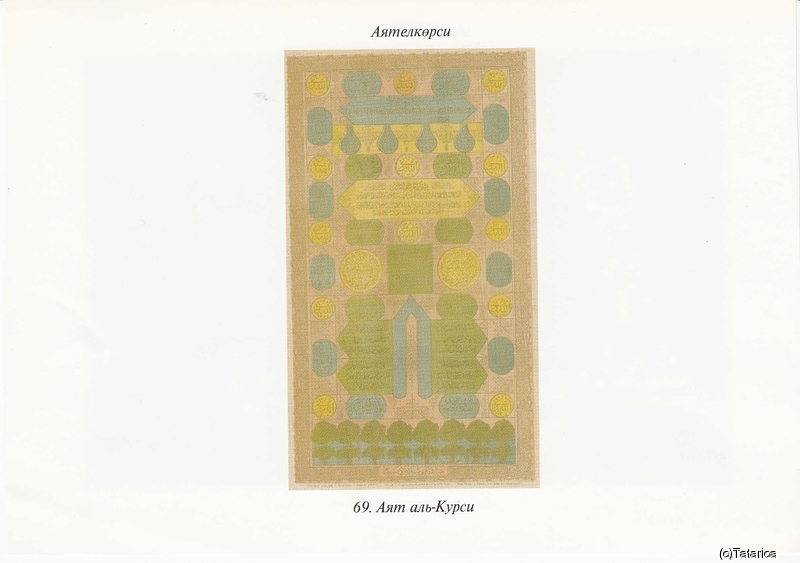
70
Шифа аятьләре. Коръәннең үзендә һәм хәдисләрендә аерым шифа аятьләре язылган. Бу шамаилдә шул аятьләрнең берничәсе китерелгән. Аста Гарәбстан картасы. Автор Куам карый Зөлфәкаров.
Целебные аяты. В Коране и хадисе приводятся целебные свойства тех или иных сур или аятов для излечения разных болезней. В шамаиле написаны шесть целебных аятов. Автор Куам Зульфакаров. Издан наследниками Ш.Хусаинова. Типо-литография Вараксина.
Medical ayats. In Koran and hadises there are curative qualities of suras and ayats for treating different kind of illnesses. In this shamail six healing ayats are written. Author is well known calligrapher Kuam Sulfakarof. Published by successors of Sh.Husainov in Kazan at Varacksin's pressing lithography house.
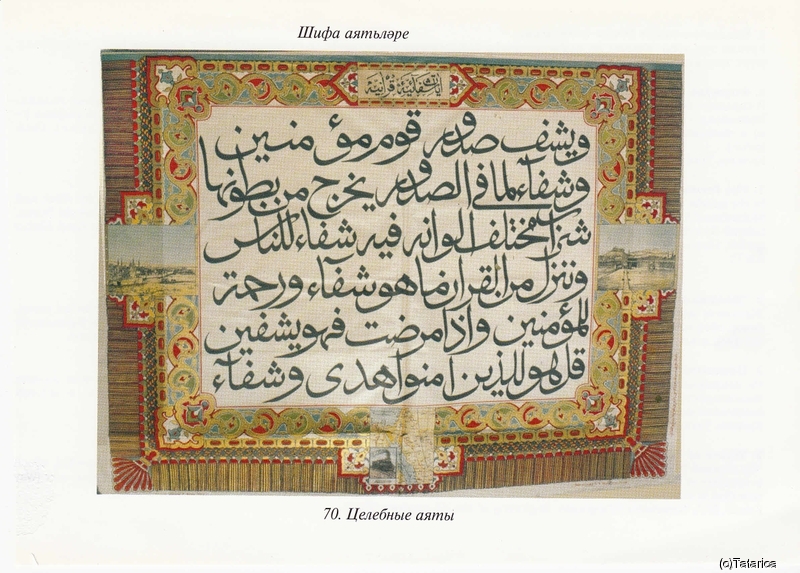
Төзүче - Рәмзия Әсраретдин кызы
autor-maker Ramzia Abzalina
Surviving Religion
Different historical events had influence on Islam among Tatars. It struggled with difficulties then had alleviations. In times of difficulties it was very important for Tatar-Muslims to not lose? But to find the ways to preserve the knowledge about ideas of Islam. Celebration of the Prophet Muhammad’s birthday –“Maulid-bairam” has become the one of the most important phenomena of religious life of Tatar-Muslims of 20th century, which helped to save the religion.
To understand role of Islam among Tatars it’s important to follow the historical aspects which affected the life of Tatar-Muslims. The main stages of the history of the Northern Islam in the Middle-Volga region of Russia were as follows.
Tatars are descendants of a wide variety of peoples ranging from Huns and Medieval Bulgars to the Mongols of Genghis’ Khan’s time. In the middle of the 5th century after the death of Attila, the Great Hun Empire began to disintegrate into several Turkic Kingdoms, among them in the 7th century, the kingdom of Great Bulgaria. Around the middle of the 7th century the Bulgars divided into two brunches. One crossed the river Danube and founded a kingdom in the Balkans.
The Danube Bulgars were strongly influenced by the native Slavs and the neighboring Byzantine Empire. By the 9th century, their language had been replaced by Slavic, and in 864 they were converted to Orthodox Christianity. The modern state of Bulgaria is named after them. The other Bulgar remained in the Eastern part of the European plains. A portion of these in the 8th century moved to the Middle Volga River and the Ural mountains where the ancient State Magna Hungaria was located. Bulgars of Great Bulgaria and Ugro-Finnic tribes of Magna Hungaria established the feudal Volga Bulgar State in the 9th century. “Balkan Bulgars, having accepted Christianity, soon lost their Turkic characteristics; nonetheless they preserved the old name of their country. The Volga-Ural Tatars, on other hand, accepted Islam and preserved most Bulgarian features except their name.”
M. Shamsutdinova states, that Tatar mythology tells that Volga-region people accepted Islam at the times of Prophet Muhammad. According to this mythology, Muhammad sent his followers – Gabdrakhman, Zubair bin Talka and Zubair bin Jadga to spread Islam to the North. He gave them his crozier, turban and inkpot, and told them to go to Great Volga-Bulgaria, Bulgar city (ancient capital of Tatars – S.B.) and preach them to accept Islam. When they reached the city, Bulgar’s Khan’s daughter was sick. They healed Khan’s daughter and Khan ordered his inhabitants to accept Islam. Zubair bin Talka married to Khan‘s daughter, whose name was Tuybike. Tuybike and Zubair bin Talka opened the Medrese for aristocratic women and started teaching them. It is said that those first 66 women who studied in that Medrese Spread Islam throughout the North. It’s believed Islam among Tatars was taken voluntarily, and it has a soft streak.
|




